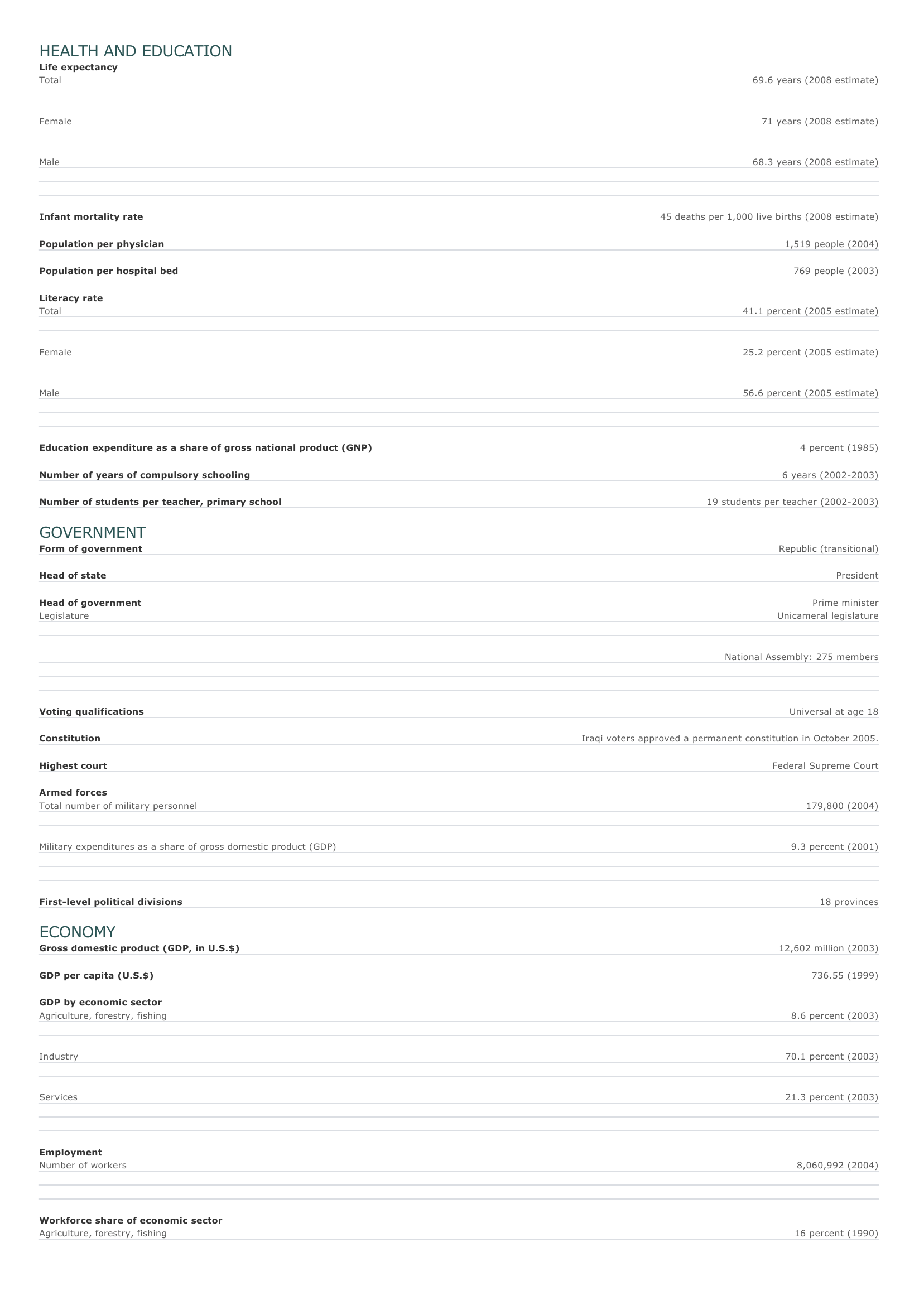Iraq Facts and Figures. BASIC FACTS Official name Capital Area Republic of Iraq Baghd? d 438,317 sq km 169,235 sq mi PEOPLE Population 28,221,181 (2008 estimate) Population growth Population growth rate 2.56 percent (2008 estimate) Projected population in 2025 40,418,381 (2025 estimate) Projected population in 2050 56,360,779 (2050 estimate) Population density 65 persons per sq km (2008 estimate) 169 persons per sq mi (2008 estimate) Urban/rural distribution Share urban 67 percent (2003 estimate) Share rural 33 percent (2003 estimate) Largest cities, with population Baghd? d 5,620,000 (2003 estimate) Irb?l 1,389,000 (2006 estimate) Mosul 2,554,000 (2006 estimate) Kirk?k 418,624 (1987) Al Ba? rah 406,296 (1987) Ethnic groups Arab 75-80 percent Kurds 15-20 percent Turkmen, Assyrian, Jews, and other 5 percent Languages Arabic (official), Kurdish (in Kurd-occupied areas), Assyrian, Armenian Religious affiliations Muslim 96 percent Shia 60-65 percent Sunni 31-36 percent Christian 3 percent O ther 1 percent HEALTH AND EDUCATION Life expectancy Total Female Male Infant mortality rate Population per physician Population per hospital bed 69.6 years (2008 estimate) 71 years (2008 estimate) 68.3 years (2008 estimate) 45 deaths per 1,000 live births (2008 estimate) 1,519 people (2004) 769 people (2003) Literacy rate Total 41.1 percent (2005 estimate) Female 25.2 percent (2005 estimate) Male 56.6 percent (2005 estimate) Education expenditure as a share of gross national product (GNP) Number of years of compulsory schooling Number of students per teacher, primary school 4 percent (1985) 6 years (2002-2003) 19 students per teacher (2002-2003) GOVERNMENT Form of government Head of state Head of government Legislature Republic (transitional) President Prime minister Unicameral legislature National Assembly: 275 members Voting qualifications Constitution Highest court Armed forces Total number of military personnel Military expenditures as a share of gross domestic product (GDP) First-level political divisions Universal at age 18 Iraqi voters approved a permanent constitution in October 2005. Federal Supreme Court 179,800 (2004) 9.3 percent (2001) 18 provinces ECONOMY Gross domestic product (GDP, in U.S.$) GDP per capita (U.S.$) GDP by economic sector Agriculture, forestry, fishing 12,602 million (2003) 736.55 (1999) 8.6 percent (2003) I ndustry 70.1 percent (2003) Services 21.3 percent (2003) Employment Number of workers 8,060,992 (2004) Workforce share of economic sector Agriculture, forestry, fishing 16 percent (1990) I ndustry 18 percent (1990) Services 66 percent (1990) Unemployment rate 26.8 percent (2004) National budget (U.S.$) Total revenue Not available Total expenditure Not available Monetary unit 1 Iraqi dinar (Id), consisting of 1,000 fil Major trade partners for exports United States, France, Netherlands, Jordan, and Italy Major trade partners for imports France, Jordan, Australia, Vietnam, and China ENERGY, COMMUNICATIONS, AND TRANSPORTATION Electricity production Electricity from thermal sources Electricity from hydroelectric sources 97.96 percent (2003 estimate) 2.04 percent (2003 estimate) Electricity from nuclear sources 0 percent (2003 estimate) Electricity from geothermal, solar, and wind sources 0 percent (2003 estimate) Number of radios per 1,000 people 229 (1997) Number of telephones per 1,000 people 37 (2004) Number of televisions per 1,000 people 82 (2000 estimate) Number of Internet hosts per 10,000 people 0 (2000) Daily newspaper circulation per 1,000 people 20 (1996) Number of motor vehicles per 1,000 people 52 (1997) Paved road as a share of total roads 84 percent (1999) SOURCES Basic Facts and People sections Area data are from the statistical bureaus of individual countries. Population, population growth rate, and population projections are from the United States Census Bureau, International Programs Center, International Data Base (IDB) (www.census.gov). Urban and rural population data are from the Food and Agriculture Organization (FAO) of the United Nations (UN), FAOSTAT database (www.fao.org). Largest cities population data and political divisions data are from the statistical bureaus of individual countries. Ethnic divisions and religion data are largely from the latest Central Intelligence Agency (CIA) World Factbook and from various country censuses and reports. Language data are largely from the Ethnologue, Languages of the World, Summer Institute of Linguistics International (www.sil.org). Health and Education section Life expectancy and infant mortality data are from the United States Census Bureau, International Programs Center, International database (IDB) (www.census.gov). Population per physician and population per hospital bed data are from the World Health Organization (WHO) (www.who.int). Education data are from the United Nations Educational, Scientific and Cultural Organization (UNESCO) database (www.unesco.org). Government section Government, independence, legislature, constitution, highest court, and voting qualifications data are largely from various government Web sites, the latest Europa World Yearbook, and the latest Central Intelligence Agency (CIA) World Factbook. The armed forces data is from Military Balance. Economy section Gross domestic product (GDP), GDP per capita, GDP by economic sectors, employment, and national budget data are from the World Bank database (www.worldbank.org). Monetary unit, agriculture, mining, manufacturing, exports, imports, and major trade partner information is from the statistical bureaus of individual countries, latest Europa World Yearbook, and various United Nations and International Monetary Fund (IMF) publications. Energy, Communication, and Transportation section Electricity information is from the Energy Information Administration (EIA) database (www.eia.doe.gov). Radio, telephone, television, and newspaper information is from the United Nations Educational, Scientific and Cultural Organization (UNESCO) database (www.unesco.org). Internet hosts, motor vehicles, and road data are from the World Bank database (www.worldbank.org). Note Figures may not total 100 percent due to rounding. Microsoft ® Encarta ® 2009. © 1993-2008 Microsoft Corporation. All rights reserved.









